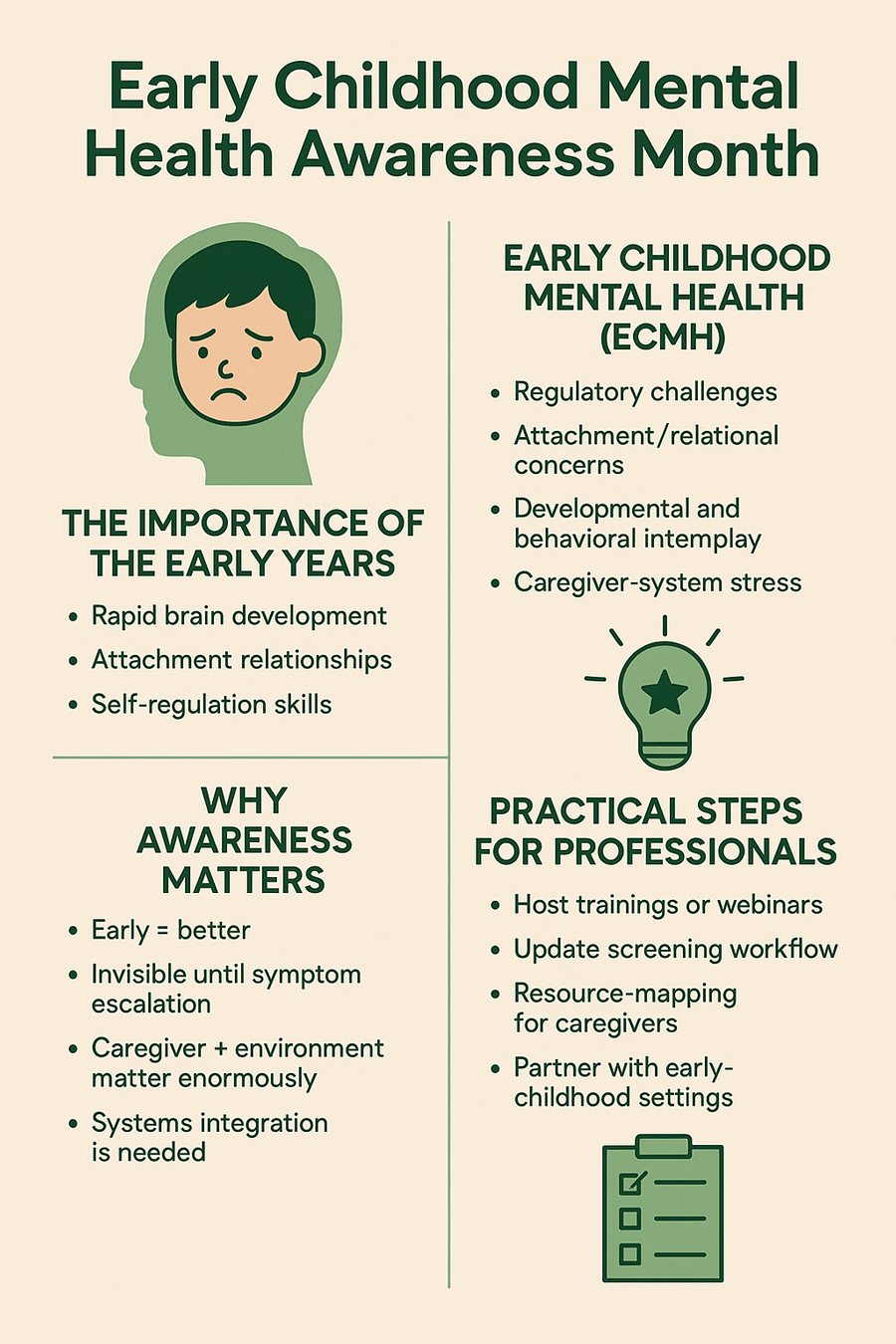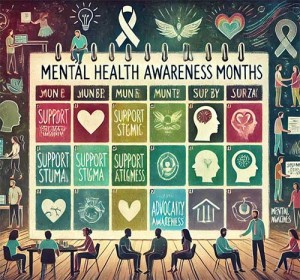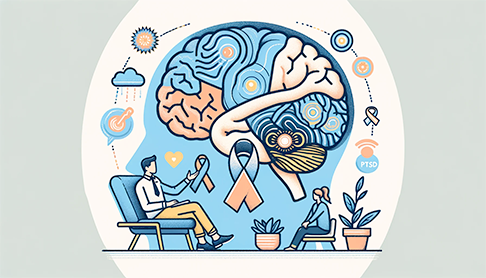Honoring Early Childhood Mental Health Awareness Month: Why Early Years Matter
November 16th, 2025

The significance of the early years
The early childhood period is marked by rapid brain development, evolving attachment relationships, and the onset of self-regulation skills. Neuroscience and developmental-psychology research show that repeated experiences of stress, trauma, or inconsistent caregiving during this sensitive window can dysregulate physiological stress systems (for example, the HPA axis, autonomic nervous system), and undermine emotion regulation, executive functioning, and relational capacities. Meanwhile, positive, stable relationships, responsive caregiving, and safe environments provide protective buffers.
For mental health professionals, this means that early identification of distress, supporting caregivers, and fostering environments of safety and attunement are not optional extras—they are foundational to promoting lifelong resilience.
What Early Childhood Mental Health (ECMH) looks like in practice
Early childhood mental health is more than simply absence of diagnosable disorders. Some key clinical foci:
-
Regulatory challenges: frequent tantrums, difficulty sleeping or feeding, intense reactions to transitions, poor self-soothing in toddlers.
-
Attachment/relational concerns: caregiver-child dyads that show persistent misattunement, avoidant or disorganized interaction patterns, caregiver mental-health or substance-use concerns that undermine the relational field.
-
Developmental and behavioral interplay: children whose emotional regulation difficulties lead to delays in play, language, peer interaction, or who exhibit irritability, aggression or withdrawal.
-
Caregiver-system stress: high caregiver stress, mental-health symptoms, poverty, housing instability, or unrelenting adversity that impact the caregiving environment.
As professionals we can adopt a strengths‐based, relationship‐focused lens: What resources exist in the child’s ecosystem (family, community, culture)? What developmental stage is the child at? How can we partner with caregivers to enhance protective relational scaffolds?
Why awareness matters—and what to spotlight this month
This awareness month provides a valuable opportunity to amplify several key messages:
-
Early = better: The earlier intervention occurs, the more plastic the developmental system and the greater the opportunity for corrective experiences. Delays in recognition and referral often mean mounting relational trauma, entrenched dysregulation, and more costly treatment later.
-
Invisible until symptom escalation: In many settings, emotional/behavioral dysregulation in preschoolers is seen as “bad behavior” or “just a phase.” Many systems (child-care, pediatric clinics, early learning) lack mental-health screening, and caregivers may not understand that “big feelings, frequent meltdowns” might signal early mental-health risk.
-
Caregiver + environment matter enormously: It’s not just the child. Supporting the adult caregivers—via psychoeducation, parental emotion-regulation coaching, linking to stress-reduction resources—equally matters. Interventions that build caregiver capacity to respond warmly and reliably yield better child outcomes.
-
Systems integration is needed: Effective ECMH services rarely sit solely in mental-health clinics. They involve early childhood programs, pediatric primary care, early intervention/IFSP systems, home-visiting programs, child-care settings, and family supports. Awareness month is a chance to engage cross-system collaboration.
-
Cultural & equity lenses matter: Many children from historically marginalized groups face cumulative adversity and lack access to early mental-health services. ECMH awareness must include culturally responsive practice, anti-bias frameworks, and system-level advocacy for access and equity.
Practical steps for mental-health professionals this month
-
Host an “early years” in-service or webinar for pediatricians, early-childhood educators, child-care partners or home-visiting staff on recognizing regulatory/relational red-flags, and making warm hand-offs to ECMH providers.
-
Update your screening workflow: Consider integrating age-appropriate screening tools (for children under 5) into intake or referral processes—such as the Ages & Stages Social-Emotional (ASQ:SE), the Devereux Early Childhood Assessment (DECA), or observational checklists of caregiver-child interaction quality.
-
Resource-mapping for caregivers: Prepare a one-page “resource map” for families with young children listing free/low-cost local options (programs for early-childhood mental health, home visiting, family support, play-therapy groups, trauma-informed child-care, etc.).
-
Partner with early-childhood settings: Reach out to ECCE (early childhood care & education) providers or early intervention services in your area and offer consultation, supervision, or on-site support (for example, reflective supervision for staff, child-care provider training in relational regulation).
-
Use social media or your practice newsletter: This month, publish a short article or infographic for caregivers: “Why Your Child’s Big Feelings Matter,” “How to Build Your Child’s FIRST 5 Years of Emotional Health,” or “When to Worry: Early Regulatory red flags.” Empower caregivers with knowledge.
-
Reflect on your lens: Take time this month to audit your own practice for accessibility (Are you welcoming to caregivers of very young children? Do you provide flexible sessions, include caregivers in treatment planning, attend to play-based or dyadic modalities?). Consider also your cultural humility: Are the early-childhood families you serve reflective of diverse backgrounds? Are you attuned to systemic barriers?
Looking ahead
As we honor Early Childhood Mental Health Awareness Month, let’s commit as mental-health professionals to elevating early relational and regulatory health as core to our mission—not just prevention, but promotion of thriving in those first years. When we collaborate with caregivers, partner with early-childhood settings, and embed relational-regulation frameworks into our work, we build a stronger foundation for children’s futures.
Remember: When a toddler’s meltdown is met with calm, relational attunement rather than frustration; when a caregiver is supported rather than judged; when systems meet children and families where they are—then early childhood mental health becomes not only possible but probable.
Note: This blog is intended for informational purposes only and does not substitute individualized clinical judgment or treatment planning. If you are working with a child or family experiencing concerns, please refer to appropriate specialists and follow your local licensing guidelines.
Climate Anxiety: The Emerging Mental Health Crisis Among Youth
May 15th, 2025
As the realities of climate change become increasingly evident, a new psychological phenomenon is gaining attention: climate anxiety. This form of distress, particularly prevalent among young people, stems from concerns about the future of our planet and the perceived inaction of leaders and institutions.
Understanding Climate Anxiety
Climate anxiety, also known as eco-anxiety, is characterized by chronic fear of environmental doom. Unlike general anxiety disorders, climate anxiety is specifically linked to environmental concerns and the existential threat posed by climate change. Symptoms can include feelings of helplessness, guilt, and a sense of loss or grief over environmental degradation.
Recent studies highlight the depth of this issue:
-
A 2021 Lancet study revealed that nearly 60% of young respondents were extremely worried about climate change, with significant numbers feeling hopeless, anxious, or angry.
-
A PNAS study found that 20% of U.S. youth aged 16-24 fear having children due to climate concerns.
The Impact on Mental Health
The psychological toll of climate anxiety is profound. Young individuals report experiencing depression, anxiety, and even PTSD-like symptoms related to climate change. The constant exposure to alarming news about environmental disasters, coupled with a perceived lack of action, exacerbates these feelings.
Moreover, the dismissal of these concerns by adults and authorities can lead to feelings of isolation and frustration among youth. This lack of validation not only intensifies their distress but also undermines their trust in societal structures.
Addressing Climate Anxiety
To mitigate the effects of climate anxiety, a multifaceted approach is necessary:
-
Validation and Open Dialogue: Recognizing and validating the feelings of those experiencing climate anxiety is crucial. Open discussions about environmental concerns can provide a sense of community and shared purpose.
-
Mental Health Support: Integrating climate-related topics into mental health services can help individuals process their emotions. Therapists and counselors should be equipped to address eco-anxiety and its unique challenges.
-
Empowerment Through Action: Encouraging participation in environmental activism can transform feelings of helplessness into proactive engagement. Taking tangible steps towards sustainability can provide a sense of control and purpose.
-
Educational Initiatives: Incorporating environmental education into school curricula can foster a deeper understanding of climate issues and promote resilience among students.
Conclusion
Climate anxiety represents a significant and growing mental health concern, particularly among younger generations. By acknowledging its existence and implementing supportive measures, society can help individuals navigate their fears and channel them into positive action. Addressing climate anxiety not only benefits individual well-being but also strengthens collective efforts towards a more sustainable future.
Note: This blog post is for informational purposes only and does not constitute medical advice. If you or someone you know is experiencing mental health issues, please consult a qualified healthcare professional.
The Importance of Observing Mental Health Awareness
March 4th, 2025

In the mental health industry, dedicating specific months and weeks to various aspects of mental well-being has become a powerful way to increase awareness, reduce stigma, and promote meaningful conversations. Whether it’s May as Mental Health Awareness Month, October as Depression Awareness Month, or even a week dedicated to suicide prevention, these observances play a crucial role in shaping public understanding and support for mental health issues.
Why Are Awareness Months and Weeks Important?
The practice of labeling specific periods for mental health topics serves several essential purposes, including:
1. Raising Awareness and Education
Many people remain uninformed about mental health conditions, treatment options, and available resources. Awareness months and weeks help bridge this gap by providing focused education, dispelling myths, and encouraging open conversations.
2. Reducing Stigma and Encouraging Dialogue
Mental health issues have historically been met with stigma, making it difficult for individuals to seek help. By associating time periods with specific mental health themes, the conversation is brought to the forefront, normalizing discussions and fostering a more accepting society.
3. Encouraging Early Detection and Intervention
When the public is educated on mental health warning signs and the importance of early intervention, individuals are more likely to recognize symptoms in themselves or others and seek help sooner. This can lead to better outcomes and a reduction in crises.
4. Providing a Platform for Advocacy
Awareness months give mental health professionals, organizations, and advocates a structured opportunity to push for systemic change, such as better access to mental health care, improved policies, and increased funding for research and treatment programs.
5. Offering Support and Community Engagement
These observances create a sense of solidarity among individuals affected by mental health conditions. Whether through online campaigns, support groups, or community events, people can find connection, validation, and encouragement during awareness-focused times.
The Role of Mental Health Professionals
As professionals in the field, counselors, therapists, and mental health advocates have a responsibility to use these designated times to:
- Host informational sessions, webinars, and community discussions.
- Share resources through social media, blogs, and public speaking engagements.
- Encourage workplaces and schools to participate in mental health initiatives.
- Provide guidance on coping strategies and self-care techniques that align with the theme of the month.
Final Thoughts
Dedicating specific months and weeks to mental health topics is more than just a symbolic gesture—it is a vital tool for education, advocacy, and support. By continuously associating timeframes with mental health awareness, we ensure that conversations remain active, people feel empowered to seek help, and progress continues in breaking down stigma. In a world where mental health is often overlooked, these observances serve as powerful reminders that mental well-being should always be a priority.
Starting the New Year: A Guide for Mental Health Professionals
December 23rd, 2024
 As a mental health professional, the dawn of a new year presents an invaluable opportunity to reflect, rejuvenate, and set intentions that enhance both personal well-being and professional efficacy. Here are key strategies to consider as you embark on the upcoming year:
As a mental health professional, the dawn of a new year presents an invaluable opportunity to reflect, rejuvenate, and set intentions that enhance both personal well-being and professional efficacy. Here are key strategies to consider as you embark on the upcoming year:
1. Prioritize Self-Care
Your capacity to support clients is intrinsically linked to your own mental and physical health. Commit to regular self-care practices, such as:
Physical Activity: Engage in consistent exercise to boost mood and reduce stress.
American Psychiatric Association
Mindfulness and Meditation: Incorporate mindfulness techniques to enhance self-awareness and emotional regulation.
Adequate Rest: Ensure sufficient sleep to maintain cognitive function and emotional balance.
2. Establish Professional Boundaries
To prevent burnout, it’s essential to set clear boundaries between your professional responsibilities and personal life.
Manage Caseloads: Assess your workload to ensure it remains sustainable.
Designate Personal Time: Allocate specific periods for relaxation and personal pursuits, free from work-related obligations.
3. Engage in Continuous Learning
The field of mental health is ever-evolving. Stay informed about the continuing education, latest research and therapeutic modalities by:
Attend Workshops and Seminars: Participate in events that expand your knowledge and skills.
Explore online learning opportunities from CEUnits.com. We offer a wide range of continuing education courses tailored to mental health professionals
Pursue Advanced Certifications: Consider obtaining certifications that align with your professional goals.
4. Reflect on Professional Practice
Take time to evaluate your therapeutic approaches and client interactions.
Seek Feedback: Engage in supervision or peer consultations to gain insights into your practice.
Set Professional Goals: Identify areas for growth and establish clear, achievable objectives for the year.
5. Foster Supportive Networks
Build connections with fellow professionals can provide emotional support and opportunities for collaboration.
Join Professional Associations: Become active in organizations that offer resources and community.
Participate in Peer Support Groups: Share experiences and strategies with colleagues to navigate the challenges of the profession.
6. Embrace Technological Tools
Leverage technology to enhance your practice and streamline administrative tasks.
Utilize Teletherapy Platforms: Expand your reach and offer flexible options for clients.
Implement Practice Management Software: Improve efficiency in scheduling, billing, and record-keeping.
7. Advocate for Mental Health Awareness
Use your expertise to promote mental health education and reduce stigma within the community.
Conduct Workshops: Offer educational sessions to the public on mental health topics.
Engage in Community Outreach: Participate in initiatives that support mental well-being.
By focusing on these areas, you not only enhance your own well-being but also strengthen your capacity to effect meaningful change in the lives of your clients. Wishing you a fulfilling and impactful new year ahead.
Supporting Patients’ Mental Health During the Holidays: Strategies for Healthcare Professionals
November 19th, 2024
 The holiday season is often romanticized as a time of joy and connection, but for many, it can exacerbate mental health challenges. The American Psychological Association (APA) reports that 38% of individuals with mental health concerns experience a worsening of their condition during the holidays. For healthcare professionals, this statistic underscores the importance of providing targeted support to patients during this challenging time.
The holiday season is often romanticized as a time of joy and connection, but for many, it can exacerbate mental health challenges. The American Psychological Association (APA) reports that 38% of individuals with mental health concerns experience a worsening of their condition during the holidays. For healthcare professionals, this statistic underscores the importance of providing targeted support to patients during this challenging time.
Why Do Mental Health Challenges Increase During the Holidays?
Understanding the root causes of heightened distress can help healthcare providers better address their patients’ needs. Common triggers include:
Financial Strain
Patients may face anxiety over increased expenses for gifts, travel, or hosting gatherings.
Social Pressures
Patients often feel overwhelmed by expectations to attend social events or project happiness.
Family Dynamics
Reuniting with family can revive unresolved conflicts or highlight painful absences.
Loneliness or Isolation
For patients without strong support systems, the season can amplify feelings of solitude.
Grief and Loss
The absence of loved ones is particularly acute during the holidays, intensifying feelings of sadness.
Seasonal Affective Disorder (SAD)
Decreased daylight during winter months can exacerbate depressive symptoms in vulnerable patients.
How Healthcare Professionals Can Help
Healthcare providers play a pivotal role in mitigating these stressors and offering practical guidance. Here are strategies for supporting patients:
Encourage Open Conversations
Create a safe space for patients to discuss their concerns. Simple questions like, “How are you feeling about the upcoming holidays?” can open the door for meaningful dialogue.
Provide Psychoeducation
Educate patients about how the holiday season can impact mental health and validate their experiences. Normalizing their feelings can reduce stigma and promote acceptance.
Promote Self-Care Practices
Suggest practical self-care strategies, such as maintaining regular sleep, exercise, and nutrition routines. Emphasize the importance of setting aside time for relaxation and mindfulness.
Help Set Realistic Expectations
Assist patients in identifying what is truly meaningful to them during the holidays. Encourage them to focus on small, manageable goals rather than striving for perfection.
Address Financial Stress
Offer advice on managing holiday expenses, such as creating a budget or finding low-cost ways to celebrate. For patients in financial distress, connect them with local resources or social services.
Support Grief Management
For patients dealing with loss, acknowledge their grief and provide coping strategies, such as journaling, creating a memorial tradition, or seeking a bereavement support group.
Monitor for Signs of Seasonal Affective Disorder (SAD)
Be vigilant about symptoms of SAD, such as persistent low mood, fatigue, and difficulty concentrating. Consider recommending light therapy or other appropriate treatments.
Encourage Social Connection
For patients feeling isolated, recommend community activities, support groups, or volunteering opportunities as ways to build connections and combat loneliness.
Provide Crisis Resources
Ensure patients have access to crisis resources, such as hotlines or local mental health services. This is particularly important for those at risk of self-harm or severe depression.
Foster Professional Collaboration
Work with other professionals, such as social workers, counselors, or case managers, to create a multidisciplinary support network for patients.
Tools for Healthcare Providers
To further support your patients, consider the following:
Workshops and Groups
Host group sessions focused on managing holiday stress or grief. This can provide patients with a sense of community and shared understanding.
Resource Lists
Compile a list of local resources, such as food banks, free counseling services, and community holiday events, to share with patients.
Preventative Check-Ins
Schedule follow-up appointments with at-risk patients before the holidays to address concerns proactively.
The Importance of Self-Care for Providers
Supporting patients through emotionally charged periods can take a toll on healthcare professionals. Prioritize your own mental health and well-being by setting boundaries, seeking peer support, and practicing self-care.
Making a Difference
As a healthcare professional, you have the unique opportunity to guide your patients through the challenges of the holiday season. By addressing their concerns with empathy and equipping them with effective strategies, you can help reduce the impact of holiday stress and foster a more positive experience. Your role is not only to treat but also to empower patients to navigate this time of year with resilience and hope.
Halloween and Mental Health: Balancing Fun and Emotional Well-Being
October 3rd, 2024
 Halloween is often associated with fun and excitement—costumes, candy, and spooky decorations. However, the holiday can also bring about unique challenges for both children and adults when it comes to mental health. Understanding how Halloween might impact emotional well-being is key to making sure it’s a positive experience for everyone.
Halloween is often associated with fun and excitement—costumes, candy, and spooky decorations. However, the holiday can also bring about unique challenges for both children and adults when it comes to mental health. Understanding how Halloween might impact emotional well-being is key to making sure it’s a positive experience for everyone.
1. Managing Fear and Anxiety
For some, Halloween’s emphasis on fright can trigger anxiety or stress. Children, especially younger ones, might find certain decorations, costumes, or haunted attractions overwhelming. Similarly, adults who experience anxiety disorders or have had traumatic experiences may feel heightened stress during the season. It’s important to recognize these feelings and find a comfortable balance between participating in the fun and protecting mental well-being. Encourage open conversations about fear and help normalize any anxious feelings.
2. Social Pressure and Perfectionism
Halloween often comes with an expectation to have the best costume or attend the most exciting party. This can create pressure for both children and adults. For kids, the pressure to “fit in” with peers can lead to stress or self-esteem issues. Adults may feel the need to create elaborate costumes or host picture-perfect events, adding to their existing responsibilities. It’s important to remind yourself (and your child) that Halloween is about fun—not perfection. Let creativity, rather than competition, guide your participation.
3. Body Image and Costume Choices
Halloween can also bring body image concerns to the forefront. For children, especially teenagers, choosing a costume can become a point of stress, particularly if they feel self-conscious about how they look compared to others. Adults may experience similar feelings, especially with costumes that emphasize certain body ideals. These issues can negatively impact mental health, leading to insecurity or low self-esteem. Focus on costumes that make you or your child feel confident and comfortable, rather than conforming to unrealistic expectations.
4. Overstimulation and Sensory Overload
Halloween events are often filled with loud noises, bright lights, and large crowds—all of which can be overwhelming for people with sensory sensitivities. Children on the autism spectrum, as well as adults with sensory processing issues, may find trick-or-treating or large parties difficult to navigate. It’s helpful to create a sensory-friendly plan, such as attending quieter events or giving children noise-reducing headphones. Setting limits on how long you or your child participates in certain activities can also help prevent overstimulation.
5. Handling Disappointment
Not every Halloween experience will meet expectations, and this can lead to feelings of disappointment. Children may be let down by not getting the candy they wanted, while adults may feel regret over a low-key celebration or an unsuccessful party. Disappointment can affect mental health, but reframing the experience in a positive light—focusing on the fun moments rather than what didn’t go as planned—can make a big difference.
6. Creating a Safe, Inclusive Atmosphere
For children with mental health challenges such as ADHD, anxiety, or autism, Halloween can feel daunting. The unpredictability and stimulation may exacerbate their symptoms. For adults with mental health disorders, especially those who have experienced trauma, Halloween may bring up difficult memories or emotions. As a family or community, it’s crucial to make Halloween as inclusive and stress-free as possible. For children, this may mean attending events designed for special needs or adjusting traditions to ensure comfort. For adults, practicing self-care and setting boundaries can make the holiday more enjoyable.
7. Mental Health Awareness and Coping Skills
Halloween can serve as a reminder of the importance of mental health awareness for both children and adults. Use the holiday as an opportunity to teach kids coping skills for dealing with fear, stress, and anxiety. Similarly, adults should check in with themselves and recognize any discomfort or stress that arises during this season. If Halloween creates too much anxiety or stress, it’s perfectly okay to opt out or create new traditions that feel better for you and your family.
Conclusion
Halloween can be a fun, creative outlet for all ages, but it’s essential to balance that excitement with mindfulness about mental health. By acknowledging the emotional challenges that can come with the holiday, we can create a more positive and mentally healthy experience for both children and adults.
This course, “Mental Health Response to Mass Violence and Terrorism,” equips professionals with essential tools to address the psychological impacts of crises, a topic made all the more relevant in today’s turbulent times. As we approach Halloween, a season often filled with themes of fear, it’s crucial to remember the real psychological toll that trauma and violence have on individuals and communities, highlighting the importance of preparedness and mental health support.
Mental Health in the Olympics: The Struggles Athletes Face
August 7th, 2024
 The Olympics are a global stage where athletes showcase their extraordinary talents, resilience, and dedication. However, behind the scenes, the pressure to perform at the highest level can take a toll on their mental health. The conversation about mental well-being in sports has gained significant attention in recent years, highlighting the need for greater awareness and support for athletes’ mental health struggles. This blog explores the challenges athletes face and the importance of addressing mental health in the context of the Olympics.
The Olympics are a global stage where athletes showcase their extraordinary talents, resilience, and dedication. However, behind the scenes, the pressure to perform at the highest level can take a toll on their mental health. The conversation about mental well-being in sports has gained significant attention in recent years, highlighting the need for greater awareness and support for athletes’ mental health struggles. This blog explores the challenges athletes face and the importance of addressing mental health in the context of the Olympics.
The Pressure to Perform
The Olympics represent the pinnacle of athletic achievement, a moment athletes train for over many years. The immense pressure to succeed can lead to anxiety, stress, and even depression. The expectations from coaches, sponsors, and fans can be overwhelming. Athletes often feel the weight of representing their country, which adds another layer of pressure. This pressure can be intensified by the global media’s scrutiny, which can sometimes focus more on an athlete’s failures than their successes.
The Stigma of Mental Health in Sports
For a long time, mental health issues in sports were stigmatized, with athletes often feeling that they had to project an image of strength and invincibility. Admitting to struggles with mental health was seen as a sign of weakness, leading many athletes to suffer in silence. This stigma has prevented many from seeking help, exacerbating their struggles and potentially leading to severe consequences.
The Role of Social Media
While social media can be a powerful tool for athletes to connect with fans and share their journeys, it can also be a double-edged sword. The constant scrutiny and criticism can exacerbate feelings of inadequacy and self-doubt. Athletes may also feel pressure to maintain a certain image, leading to a disconnect between their public persona and their private struggles. The negative comments and trolling on social media can contribute to anxiety and depression, making it harder for athletes to focus on their performance.
The Impact of Isolation
Training for the Olympics often requires long hours of practice and travel, which can lead to isolation from family and friends. This isolation can contribute to feelings of loneliness and disconnect. The pandemic has further highlighted the challenges of isolation, with many athletes facing restrictions on training and competition. The lack of social support can make it difficult for athletes to cope with the stress and pressure of competition.
The Importance of Mental Health Support
In recent years, there has been a growing recognition of the importance of mental health in sports. Many organizations and governing bodies are taking steps to provide athletes with access to mental health resources and support. This includes counseling services, mental skills training, and education on mental health awareness. The conversation is slowly shifting towards a more compassionate and understanding approach to athletes’ mental well-being.
Athletes Leading the Conversation
High-profile athletes like Simone Biles, Michael Phelps, and Naomi Osaka have courageously shared their struggles with mental health, helping to break down the stigma and encourage others to seek help. Their openness has sparked important conversations about the pressures athletes face and the need for comprehensive support systems. By sharing their stories, these athletes have shown that mental health challenges are not a sign of weakness but a common and normal aspect of the human experience.
Conclusion
The mental health struggles faced by Olympic athletes are a critical issue that deserves attention and compassion. As the world watches these incredible individuals compete, it is essential to remember that they are more than just athletes—they are people with emotions, fears, and vulnerabilities. By fostering an environment that prioritizes mental well-being, we can help athletes thrive both on and off the field. The ongoing conversation about mental health in sports is a step in the right direction, and it is up to all of us to continue supporting and advocating for the mental well-being of athletes at every level.
PTSD Awareness Month: A Scientific Perspective on Mental Health
June 6th, 2024
 June is PTSD Awareness Month, a critical period dedicated to increasing understanding and awareness of Post-Traumatic Stress Disorder (PTSD). PTSD is a mental health condition triggered by experiencing or witnessing a traumatic event. This month highlights the importance of addressing PTSD with a scientific and evidence-based approach to improve mental health outcomes.
June is PTSD Awareness Month, a critical period dedicated to increasing understanding and awareness of Post-Traumatic Stress Disorder (PTSD). PTSD is a mental health condition triggered by experiencing or witnessing a traumatic event. This month highlights the importance of addressing PTSD with a scientific and evidence-based approach to improve mental health outcomes.
The Neurobiology of PTSD
PTSD is characterized by alterations in brain function and structure. Neuroimaging studies have identified changes in the amygdala, prefrontal cortex, and hippocampus. The amygdala, responsible for emotional processing, often shows heightened activity in individuals with PTSD. In contrast, the prefrontal cortex, which regulates emotional responses, may exhibit decreased activity, impairing its ability to modulate the amygdala’s response. The hippocampus, involved in memory formation, may also be reduced in size, contributing to the difficulties in distinguishing between past and present threats.
Symptoms and Diagnosis
PTSD symptoms can be classified into four main categories: intrusive thoughts, avoidance behaviors, negative alterations in cognition and mood, and hyperarousal. These symptoms must persist for more than a month and cause significant distress or impairment in social, occupational, or other important areas of functioning for a diagnosis to be made. The Diagnostic and Statistical Manual of Mental Disorders (DSM-5) provides standardized criteria for diagnosing PTSD.
Pathophysiology and Risk Factors
The pathophysiology of PTSD involves complex interactions between genetic, environmental, and psychological factors. Genetic predispositions, such as variations in the FKBP5 gene, can influence the risk of developing PTSD by affecting the hypothalamic-pituitary-adrenal (HPA) axis response to stress. Environmental factors, including the severity and duration of the traumatic event, also play a crucial role. Psychological factors, such as pre-existing mental health conditions and personality traits, can further modulate an individual’s response to trauma.
Evidence-Based Treatments
Effective treatment of PTSD often involves a combination of pharmacological and psychotherapeutic interventions. Selective serotonin reuptake inhibitors (SSRIs) are commonly prescribed to help manage symptoms. Psychotherapy, particularly trauma-focused cognitive-behavioral therapy (CBT) and eye movement desensitization and reprocessing (EMDR), has shown significant efficacy in treating PTSD.
Importance of Awareness and Research
Raising awareness about PTSD is vital for reducing stigma and encouraging individuals to seek help. Ongoing research is essential to develop better diagnostic tools and treatments. Advances in neuroimaging, genetics, and psychopharmacology continue to provide insights into the mechanisms underlying PTSD and potential therapeutic targets.
Supporting Those Affected
Support for individuals with PTSD includes providing access to mental health resources, encouraging professional treatment, and fostering a supportive environment. Public health initiatives and educational campaigns can play a crucial role in disseminating information and promoting mental health literacy.
Conclusion
PTSD Awareness Month emphasizes the need for a scientific understanding of PTSD to improve diagnosis, treatment, and support for those affected. By leveraging research and evidence-based practices, we can enhance the quality of life for individuals with PTSD and contribute to broader mental health advancements. This June, let’s commit to advancing our knowledge and compassion for those living with PTSD, recognizing that mental health is an integral part of overall health.
By integrating scientific research and community support, we can make meaningful strides in addressing PTSD and fostering a healthier society.
Take our PTSD course here PTSD: New Understandings and Interventions
This course delves into the latest research to explore how the body and mind respond to extreme stress and trauma, including the factors that may lead to a problematic response. Insights are drawn from recent studies on memory and the body’s neuro-hormonal reaction and regulation mechanisms. Additionally, the course provides an overview of contemporary biological, psychotherapeutic, and medication-based strategies for preventing and treating acute stress disorder and PTSD.
Handy List of Words for Healthcare Workers
April 20th, 2024
As a healthcare worker, you are required to keep case notes. It’s important to maintain detailed records through case documentation. It allows you to create successful outcomes for your clients. Always make sure your case notes are useful. Do your best to make sure they provide insight and value. Analyze your notes and see if they would be useful to another case worker. You want to make sure you give an accurate picture of the client’s history, as well as their current situation.
It’s important to use language that is non-judgmental. Neutral language is the most common form of case notes in social work. It’s also helpful if you avoid making assumptions and remember to stick to the concrete facts. You should always indicate clearly when a comment is an observation. It is imperative you make it clear when you are recording the client’s own words by using quotation marks.
Notes are important in this type of work because the courts can subpoena records and other reports; you have to be careful about what you say about your respective client. Write your case notes immediately after you have spoken with a client. Here’s a handy list of words that many social workers use while writing up their case notes:
- Acknowledged
Actively Listened
Addressed
Advised
Advocated
Asked
Assisted
Challenging
Checked In
Clarified
Collaborated
Commended
Confronted
Conducted
Conveyed
Crisis Intervention
Developed
Educated
Empathized
Empowered
Encouraged
Ensured
Established
Explained
Explored
Expressed
Facilitated
Focusing/Refocusing
Framing/Reframing
Goal (setting)
Development/Goal Setting
Guided
Highlighted
Honoring
Identified
Information Giving/Gathering
Informed
Interacted
Interpreted
Joined
Modeled
Observed
Physical Activity
Played
Praised
Presented
Probed
Problem Solving
Prompted
Rapport-building
Recapped
Recommended
Redirected
Reflected
Reflective Listening
Reframed
Reinforced
Reiterated
Reminded
Reviewed
Role-played
Social Skills Practice
Suggested
Supported
Teaching/Lecturing
Urge
Elevate Your Professional Growth in 2024: A Helpful Guide to Continuing Education
April 2nd, 2024
 In the fast-paced world of modern professions, staying ahead of the curve is paramount. For professionals like social workers, counselors, and therapists, Continuing Education (CE) isn’t just a requirement—it’s a gateway to staying relevant, informed, and effective in their roles. As we step into 2024, the landscape of continuing education has evolved, presenting both challenges and opportunities. In this blog post, we’ll explore the best way to tackle your continuing education needs in 2024 and why CEUnits.com stands out as your ideal partner in this journey.
In the fast-paced world of modern professions, staying ahead of the curve is paramount. For professionals like social workers, counselors, and therapists, Continuing Education (CE) isn’t just a requirement—it’s a gateway to staying relevant, informed, and effective in their roles. As we step into 2024, the landscape of continuing education has evolved, presenting both challenges and opportunities. In this blog post, we’ll explore the best way to tackle your continuing education needs in 2024 and why CEUnits.com stands out as your ideal partner in this journey.
Why Continuing Education Matters in 2024
The field of social work, counseling, and therapy is dynamic, with evolving practices, ethical considerations, and legal frameworks. To provide the best possible care and support to clients, professionals must continuously update their knowledge and skills. Here’s why continuing education matters more than ever in 2024:
- Adapting to Change: Societal, technological, and legislative changes continually reshape the landscape of mental health and social work professions. CE ensures professionals stay informed about the latest developments, ensuring their methods remain relevant and effective.
- Enhancing Competence: Continuing education allows professionals to delve deeper into specialized areas, honing their expertise and expanding their professional toolkit. This not only benefits clients but also enhances job satisfaction and career prospects.
- Maintaining Licensure: Many regulatory bodies mandate a certain number of CE credits to maintain licensure. By fulfilling these requirements, professionals uphold the highest standards of practice and uphold their professional standing.
- Networking and Collaboration: CE events provide valuable opportunities for networking, collaboration, and knowledge exchange with peers and experts in the field. These interactions can spark new ideas, foster innovation, and create a supportive professional community.
The Best Way to Complete Your Continuing Education in 2024
With the myriad of options available for continuing education, finding the best approach can be daunting. Here are some tips to streamline your CE journey in 2024:
- Set Clear Goals: Before embarking on your CE journey, define your professional goals and areas for growth. This will help you tailor your education to your specific needs and interests.
- Choose Quality Programs: Look for CE providers with a reputation for excellence and accreditation from relevant professional bodies. Quality programs ensure that you receive relevant, up-to-date, and credible education.
- Embrace Flexibility: In a digital age, flexibility is key. Opt for CE platforms that offer a diverse range of online courses, webinars, and self-paced learning modules. This allows you to learn on your own schedule, without compromising on quality.
- Prioritize Engagement: Seek out CE experiences that prioritize interactive learning, discussions, and case studies. Active engagement enhances retention and application of knowledge, ensuring maximum value from your education.
Why CEUnits.com is Your Ideal CE Partner
Amidst the plethora of CE providers, CEUnits.com stands out as a beacon of excellence and convenience. Here’s why:
- Diverse Course Offerings: CEUnits.com boasts a comprehensive library of courses spanning various specialties, including social work, counseling, and therapy. Whatever your area of interest or specialization, you’ll find relevant and engaging courses to fulfill your CE requirements.
- Expert-Led Content: Each course on CEUnits.com is developed and delivered by industry experts, ensuring high-quality, evidence-based education. Whether you’re seeking to deepen your understanding of clinical practice, ethics, or legal frameworks, you can trust that you’re learning from the best in the field.
- User-Friendly Platform: CEUnits.com offers a seamless, user-friendly platform designed for maximum convenience and accessibility. With intuitive navigation, mobile compatibility, and easy course access, learning has never been more convenient.
- Recommendation: Law and Ethics in Clinical Practice: As a testament to our commitment to excellence, CEUnits.com offers a stellar course titled “Law and Ethics in Clinical Practice.” This course delves into the complex intersection of legal and ethical considerations in clinical settings, equipping you with the knowledge and skills to navigate challenging situations with confidence and integrity.
In conclusion, continuing education is not just a requirement—it’s a gateway to professional growth, excellence, and fulfillment. By partnering with CEUnits.com and embracing a proactive approach to learning, you can elevate your practice, advance your career, and make a lasting impact on the lives of those you serve.

